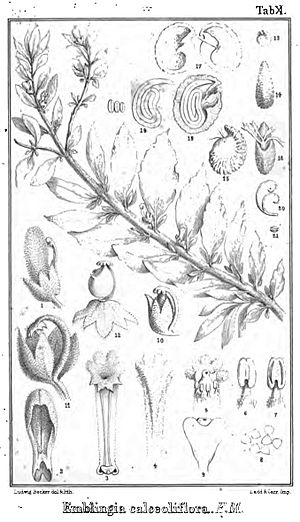Emblingia facts for kids
Quick facts for kids Emblingia |
|
|---|---|
 |
|
| Scientific classification | |
| Genus: |
Emblingia
|
| Species: |
calceoliflora
|
Emblingia is a very special plant. It has only one known species, called Emblingia calceoliflora. This plant is a small, low-growing shrub. It is found only in Western Australia. Scientists believe it is so unique that it belongs in its own plant family, called Emblingiaceae.
Contents
What Does Emblingia Look Like?
Emblingia calceoliflora is a perennial plant. This means it lives for more than two years. It is a herbaceous subshrub, which means it has soft stems but also some woody parts. It grows low to the ground. Its leaves have a tough, hard edge, almost like cartilage. The leaves also have small stalks called petioles.
The flowers of Emblingia calceoliflora are not regular in shape. They can be white, cream, yellow, green, or pink. You can usually see them blooming from August to November. After the flowers, the plant produces a fruit. This fruit is not fleshy or juicy.
How Scientists Classified Emblingia
The Emblingia plant was first officially described in 1861. A famous scientist named Ferdinand von Mueller gave it its name. He studied plant samples collected in the Murchison region. These samples were gathered by Pemberton Walcott and Augustus Frederick Oldfield.
For a long time, scientists found it hard to decide where Emblingia fit in the plant family tree. It was placed in different families over the years. Some thought it belonged with plants like Capparaceae or Sapindaceae.
In 1965, another scientist, Herbert Kenneth Airy Shaw, created a new family just for this plant. He named it Emblingiaceae. Today, many plant classification systems use this family for Emblingia. Modern studies, which look at the plant's DNA, confirm its unique place. They show it belongs to a larger group of plants called Brassicales.
Where Does Emblingia Grow?
Emblingia calceoliflora is endemic to Western Australia. This means it grows naturally only in this part of the world. It likes to grow in sandy soils. These soils can be grey, yellow, or red. You can find it on rolling sandplains along the west coast.
It is most common in two specific areas. These are the Geraldton Sandplains and the Carnarvon regions. It also grows a little bit on the northwestern edge of the Avon Wheatbelt area.
Is Emblingia Threatened?
Scientists do not consider Emblingia calceoliflora to be a threatened plant. This means it is not currently at risk of disappearing.

